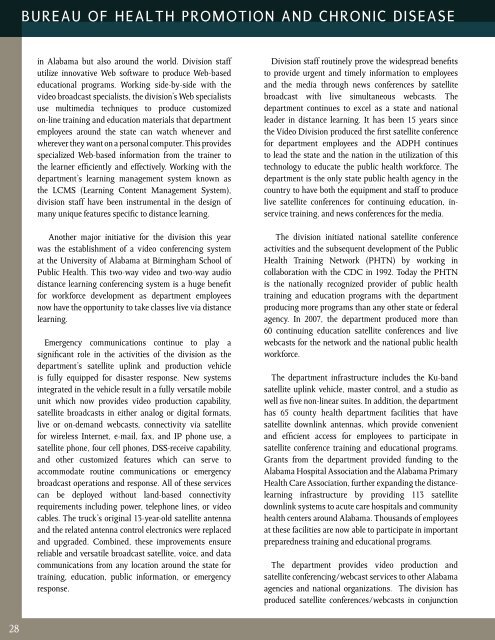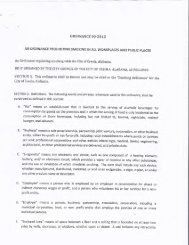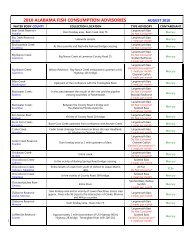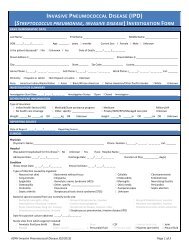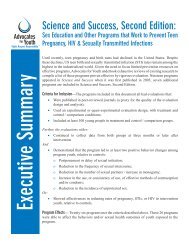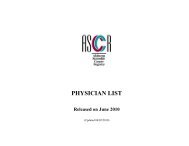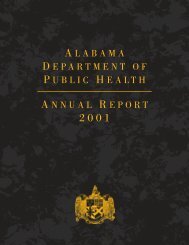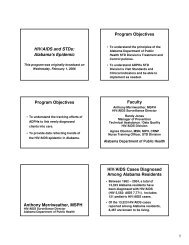2007 - Alabama Department of Public Health
2007 - Alabama Department of Public Health
2007 - Alabama Department of Public Health
Create successful ePaper yourself
Turn your PDF publications into a flip-book with our unique Google optimized e-Paper software.
ureau <strong>of</strong> health promotion and chronic disease<br />
in <strong>Alabama</strong> but also around the world. Division staff<br />
utilize innovative Web s<strong>of</strong>tware to produce Web-based<br />
educational programs. Working side-by-side with the<br />
video broadcast specialists, the division’s Web specialists<br />
use multimedia techniques to produce customized<br />
on-line training and education materials that department<br />
employees around the state can watch whenever and<br />
wherever they want on a personal computer. This provides<br />
specialized Web-based information from the trainer to<br />
the learner efficiently and effectively. Working with the<br />
department’s learning management system known as<br />
the LCMS (Learning Content Management System),<br />
division staff have been instrumental in the design <strong>of</strong><br />
many unique features specific to distance learning.<br />
Another major initiative for the division this year<br />
was the establishment <strong>of</strong> a video conferencing system<br />
at the University <strong>of</strong> <strong>Alabama</strong> at Birmingham School <strong>of</strong><br />
<strong>Public</strong> <strong>Health</strong>. This two-way video and two-way audio<br />
distance learning conferencing system is a huge benefit<br />
for workforce development as department employees<br />
now have the opportunity to take classes live via distance<br />
learning.<br />
Emergency communications continue to play a<br />
significant role in the activities <strong>of</strong> the division as the<br />
department’s satellite uplink and production vehicle<br />
is fully equipped for disaster response. New systems<br />
integrated in the vehicle result in a fully versatile mobile<br />
unit which now provides video production capability,<br />
satellite broadcasts in either analog or digital formats,<br />
live or on-demand webcasts, connectivity via satellite<br />
for wireless Internet, e-mail, fax, and IP phone use, a<br />
satellite phone, four cell phones, DSS-receive capability,<br />
and other customized features which can serve to<br />
accommodate routine communications or emergency<br />
broadcast operations and response. All <strong>of</strong> these services<br />
can be deployed without land-based connectivity<br />
requirements including power, telephone lines, or video<br />
cables. The truck’s original 13-year-old satellite antenna<br />
and the related antenna control electronics were replaced<br />
and upgraded. Combined, these improvements ensure<br />
reliable and versatile broadcast satellite, voice, and data<br />
communications from any location around the state for<br />
training, education, public information, or emergency<br />
response.<br />
Division staff routinely prove the widespread benefits<br />
to provide urgent and timely information to employees<br />
and the media through news conferences by satellite<br />
broadcast with live simultaneous webcasts. The<br />
department continues to excel as a state and national<br />
leader in distance learning. It has been 15 years since<br />
the Video Division produced the first satellite conference<br />
for department employees and the ADPH continues<br />
to lead the state and the nation in the utilization <strong>of</strong> this<br />
technology to educate the public health workforce. The<br />
department is the only state public health agency in the<br />
country to have both the equipment and staff to produce<br />
live satellite conferences for continuing education, inservice<br />
training, and news conferences for the media.<br />
The division initiated national satellite conference<br />
activities and the subsequent development <strong>of</strong> the <strong>Public</strong><br />
<strong>Health</strong> Training Network (PHTN) by working in<br />
collaboration with the CDC in 1992. Today the PHTN<br />
is the nationally recognized provider <strong>of</strong> public health<br />
training and education programs with the department<br />
producing more programs than any other state or federal<br />
agency. In <strong>2007</strong>, the department produced more than<br />
60 continuing education satellite conferences and live<br />
webcasts for the network and the national public health<br />
workforce.<br />
The department infrastructure includes the Ku-band<br />
satellite uplink vehicle, master control, and a studio as<br />
well as five non-linear suites. In addition, the department<br />
has 65 county health department facilities that have<br />
satellite downlink antennas, which provide convenient<br />
and efficient access for employees to participate in<br />
satellite conference training and educational programs.<br />
Grants from the department provided funding to the<br />
<strong>Alabama</strong> Hospital Association and the <strong>Alabama</strong> Primary<br />
<strong>Health</strong> Care Association, further expanding the distancelearning<br />
infrastructure by providing 113 satellite<br />
downlink systems to acute care hospitals and community<br />
health centers around <strong>Alabama</strong>. Thousands <strong>of</strong> employees<br />
at these facilities are now able to participate in important<br />
preparedness training and educational programs.<br />
The department provides video production and<br />
satellite conferencing/webcast services to other <strong>Alabama</strong><br />
agencies and national organizations. The division has<br />
produced satellite conferences/webcasts in conjunction<br />
28


